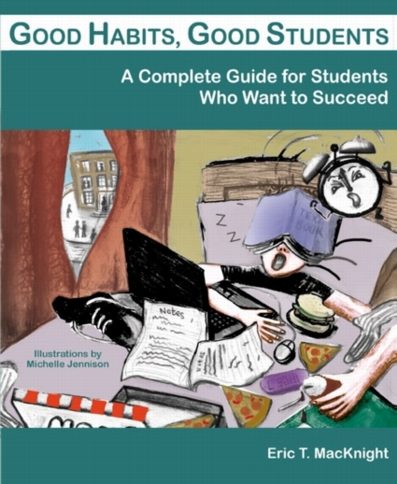Eric MacKnight has had a wide experience of teaching, initially in the US and for many more recent years in the international school sector, which is where I met and worked with him, experiencing at first hand his unbounded enthusiasm for helping struggling students to improve. Over the years he amassed through trial and error, a valuable store of handouts.
He sums it up: “I discovered early on that the standard advice on setting goals offers little practical help. Students need guidance and practice in setting goals that will actually work . . . before long I saw that I had a book on my hands.”
Modestly , but realistically Eric MacKnight makes no claims to “solving all the problems students face in schools, or offer yet another scheme to reform education;” however he does offer teachers and students a step-by-step route to the knowledge and skills that students need to improve the habits that form the basis to success in school.
Whilst the guide will be a goldmine of good ideas for teachers, it is written for and aimed at students. It is easy to read, clear in the instructions or advice that is given, practical and often amusing and enhanced by some attractive and witty illustrations by Michelle Jennison. The book covers the improvement of ‘Personal Habits’, ‘Work Habits’, Study Habits’, and ‘Study Skills’.
Part One considers ways to ‘Improve your Habits’ and the students are immediately engaged on working out for themselves where improvement is needed and what personal goals are to be set. This is indeed an important value of the book. Students are not instructed by teacher, told what to do and given goals but are encouraged through self motivation to improve.
Part Two looks at ‘Eleven Personal Habits’. These are the basis for self improvement and this section contains a wealth of useful advice — not dictated, but interestingly and convincingly suggested. Again the tone is practical. The section called ‘Take responsibility for your mistakes’ is sub-sectioned ‘Apologise, fix it, and move on’. Good advice — not just for a student!
Every so often in the text there is a boxed section with anecdotes about famous people, ideas, an appropriate quotation or a joke . Eric Macknight certainly understands the psychology of students who like nothing better than to be diverted every now and then by a good story or illustration.
This section is followed by consideration of some specific work habits.
The next sections cover ‘Study Habits’ which includes time planning, preparation for exams, and other practical issues and then a consideration of ‘Three Essential Study Skills’ which are ‘Learning how to read efficiently’, ‘Take notes in a way that works for you’ and ‘How to prepare for tests’. Again the emphasis is on the individual, stressing that we do not all learn in the same way, but need to make our own decisions and create our own plan of action.
The book ends with an Appendix . This is where teachers will find some very useful handouts, including ‘Goal Setting Aids’, ‘Sample Goals’, ‘A Note on Learning Disabilities’ and ‘A Note to Parents and Teachers: How You Can Help’.
One of the most popular books of the nineteenth century, which went into dozens of editions was Samuel Smiles Self Help. In the preface it says:
‘The object of this book is to re-inculcate this wholesome lesson — that youth must work in order to enjoy — that nothing creditable can be accomplished without application and diligence , that the student must not be daunted by difficulties, but conquer them by patience and perseverance; the spirit of self help is the root of all genuine growth of the individual.’
Of course Samuel Smiles was writing in a different time and certainly in a very different style, but the message remains similar. Just as his book was a help and inspiration to thousands of aspiring scholars so Good Habits, Good Students will I am sure be a useful guide for a great many students of today and in the future. There is no doubt that if I was still teaching I would get a copy of Eric MacKnight’s book for each of my younger secondary school students, and work through it with them over the year.
Caroline Ellwood
International School, the official magazine for ECIS
Spring / Autumn 2007
Volume 9, Issue 2

